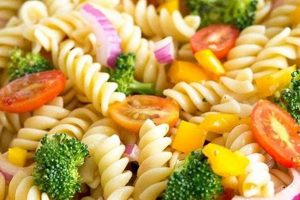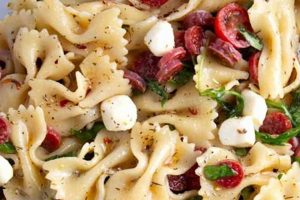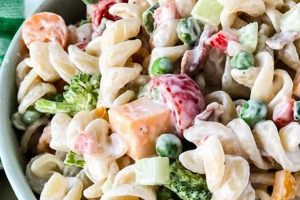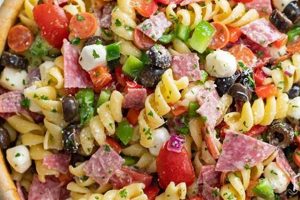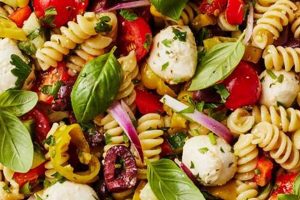This dish typically combines farfalle pasta, often referred to as bow tie pasta due to its distinctive shape, with pesto, a sauce traditionally made from basil, pine nuts, garlic, Parmesan cheese, and olive oil. Variations often incorporate additional ingredients such as vegetables, proteins, and cheeses to create diverse flavor profiles and textures. Examples include adding sun-dried tomatoes and grilled chicken for a heartier meal, or incorporating fresh mozzarella and cherry tomatoes for a lighter, summery option.
The appeal of this type of pasta salad lies in its versatility and balanced flavors. Pesto provides a vibrant, herbaceous base, while the bow tie pasta’s shape holds the sauce well. This combination offers a refreshing and satisfying culinary experience, suitable for picnics, potlucks, light lunches, or side dishes. Furthermore, the dish allows for significant customization based on dietary preferences and seasonal ingredient availability, contributing to its enduring popularity.
Explorations of this dish can delve into the nuances of pesto preparation, different pasta cooking methods, and the vast array of complementary ingredients that can elevate this simple combination to a culinary masterpiece. Considerations for ingredient selection, nutritional value, and creative presentation will also be addressed.
Tips for Creating Exceptional Bow Tie Pesto Pasta Salad
Elevating a simple pasta salad to an extraordinary culinary experience involves attention to detail and a thoughtful approach to ingredient selection and preparation. The following tips offer guidance for crafting a memorable dish.
Tip 1: Salt the Pasta Water Generously. Adequate salting of the cooking water is crucial for seasoning the pasta itself. The water should taste like seawater.
Tip 2: Cook Pasta al Dente. Slightly firm pasta holds its shape better in a salad and prevents a mushy texture. Follow package directions, checking for doneness a minute or two before the recommended time.
Tip 3: Use High-Quality Pesto. Whether store-bought or homemade, the pesto’s quality significantly impacts the overall flavor. Look for vibrant color and fresh ingredients.
Tip 4: Balance Flavors and Textures. Consider incorporating ingredients that complement the pesto. Roasted vegetables, grilled chicken or shrimp, sun-dried tomatoes, and various cheeses offer textural and flavor contrasts.
Tip 5: Don’t Overdress the Salad. Start with a smaller amount of pesto and add more gradually to avoid an overly oily or heavy salad. The pasta should be coated lightly, not swimming in sauce.
Tip 6: Chill Before Serving (Optional). Chilling allows the flavors to meld, creating a more cohesive dish. However, some prefer the pasta salad served immediately at room temperature.
Tip 7: Garnish Thoughtfully. A simple garnish can enhance visual appeal and add a final layer of flavor. Consider toasted pine nuts, fresh basil leaves, or a sprinkle of grated Parmesan.
By following these tips, one can achieve a pasta salad that is not only visually appealing but also offers a delightful balance of flavors and textures, ensuring a truly satisfying dining experience.
Through careful consideration of these elements, crafting a truly exceptional bow tie pesto pasta salad becomes an achievable culinary endeavor.
1. Bow Tie Pasta
Bow tie pasta, also known as farfalle, plays a crucial role in bow tie pesto pasta salad recipes, contributing significantly to both the aesthetic appeal and the overall culinary experience. The pasta’s distinctive shape, resembling a bow tie or butterfly, offers several advantages in the context of pasta salads. Its folds and curves effectively capture and hold the pesto, ensuring even distribution of flavor throughout the dish. This characteristic prevents the pesto from pooling at the bottom of the bowl, a common issue with smoother pasta shapes. Additionally, the larger surface area of bow tie pasta allows for greater absorption of the sauce, intensifying the pesto’s flavor profile.
The choice of bow tie pasta over other shapes impacts the overall texture and enjoyment of the salad. For example, using long, thin pasta like spaghetti would result in a less cohesive salad, as the pesto would not adhere as effectively. The structural integrity of bow tie pasta also prevents it from becoming overly mushy when combined with the pesto and other ingredients, maintaining a pleasant firmness even after being chilled. This characteristic proves particularly advantageous in preparing make-ahead pasta salads, where maintaining texture over time is essential. Consider a picnic scenario: a bow tie pesto pasta salad will hold its shape and texture far better than a salad made with smaller, more delicate pasta shapes.
Selecting bow tie pasta for this type of salad showcases a deliberate culinary choice that prioritizes both flavor and texture. The pasta’s ability to capture and hold the pesto, combined with its structural integrity, contributes to a more satisfying and enjoyable dining experience. While other pasta shapes could technically be used, they would not deliver the same level of flavor distribution, textural contrast, or visual appeal. Understanding the significance of bow tie pasta’s unique qualities underscores its essential role in creating a successful bow tie pesto pasta salad.
2. Fresh Pesto
Fresh pesto forms the heart of bow tie pesto pasta salad recipes, contributing the characteristic vibrant green hue and distinctive flavor profile that defines the dish. Understanding the nuances of pesto preparation and its impact on the final product is crucial for creating a successful and flavorful salad.
- Ingredient Quality
The quality of ingredients directly impacts the pesto’s flavor. Fresh basil leaves, preferably young and tender, provide the foundational herbaceous note. High-quality olive oil contributes richness and a smooth texture. Freshly grated Parmesan cheese adds a salty, umami element, while pine nuts offer a delicate sweetness and subtle crunch. Garlic, used sparingly, provides a pungent accent. Compromising on ingredient quality can result in a dull, less vibrant pesto that diminishes the overall salad’s appeal. For instance, using pre-grated Parmesan cheese, which often contains cellulose as an anti-caking agent, can lead to a gritty texture and muted flavor.
- Preparation Method
Traditional pesto preparation involves pounding the ingredients together using a mortar and pestle. This method gently releases the basil’s essential oils, resulting in a vibrant, emulsified sauce. While food processors offer a convenient alternative, over-processing can bruise the basil, leading to a slightly bitter taste and a less vibrant green color. Careful attention to processing time and technique is essential for achieving optimal results. A quick pulse, rather than a continuous blend, helps preserve the basil’s freshness and color.
- Flavor Balance
Achieving a balanced flavor profile within the pesto itself is essential for a harmonious pasta salad. The intensity of the garlic, the saltiness of the Parmesan, and the richness of the olive oil should complement the basil’s fresh, herbaceous notes without overpowering them. Adjusting ingredient ratios according to personal preference allows for customization while maintaining the pesto’s fundamental character. For example, reducing the amount of garlic can create a milder pesto, while increasing the Parmesan enhances its savory depth.
- Storage and Freshness
Freshly made pesto offers the most vibrant flavor and color. However, proper storage techniques can extend its shelf life. Storing pesto in an airtight container with a thin layer of olive oil on top helps prevent oxidation and browning. Refrigeration allows for storage for up to a week, though the flavor is best within the first few days. Freezing pesto in ice cube trays allows for portioned use and preserves its freshness for extended periods. Using fresh, properly stored pesto ensures the bow tie pasta salad retains its optimal flavor and visual appeal.
The quality and freshness of the pesto significantly influence the overall success of a bow tie pesto pasta salad. From sourcing premium ingredients to employing meticulous preparation techniques and proper storage methods, each step contributes to the final dish’s flavor, texture, and visual appeal. A well-crafted pesto elevates the simple combination of pasta and other ingredients, transforming it into a culinary experience that is both refreshing and satisfying.
3. Complementary Ingredients
Complementary ingredients play a crucial role in elevating bow tie pesto pasta salad recipes beyond the foundational combination of pasta and pesto. These additions introduce layers of flavor, texture, and visual appeal, transforming a simple dish into a more complex and satisfying culinary experience. The selection of complementary ingredients should consider the pesto’s inherent flavorsthe herbaceous basil, the rich olive oil, the salty Parmesanand aim to enhance, not overpower, these core components. A thoughtful approach to ingredient selection ensures a balanced and harmonious final product.
Several categories of complementary ingredients commonly enhance bow tie pesto pasta salads. Vegetables offer textural contrast and contribute freshness. Roasted vegetables, such as bell peppers, zucchini, or cherry tomatoes, provide a sweetness that complements the pesto’s savory notes. Grilled or blanched vegetables, like asparagus or green beans, offer a crisp, bright counterpoint. Protein additions, such as grilled chicken, shrimp, or chickpeas, create a heartier salad suitable for a main course. Cheeses, beyond the Parmesan in the pesto, can add depth of flavor and textural complexity. Fresh mozzarella provides a creamy, milky contrast, while crumbled feta offers a salty, tangy element. Furthermore, additions like sun-dried tomatoes offer a concentrated burst of umami, while toasted pine nuts provide a satisfying crunch. The choice of complementary ingredients often depends on the desired overall flavor profile and the occasion for which the salad is being prepared.
Understanding the interplay between complementary ingredients and the foundational elements of a bow tie pesto pasta salad allows for greater culinary creativity and control. The careful selection and balance of these additions contribute significantly to the dish’s overall success. A well-composed bow tie pesto pasta salad showcases not only the vibrant flavors of the pesto but also the harmonious integration of complementary ingredients, resulting in a balanced and satisfying culinary creation. Considerations such as seasonality, dietary restrictions, and personal preferences further refine the selection process, enabling the creation of truly personalized and exceptional pasta salads.
4. Proper Cooking Technique
Proper cooking technique is paramount in achieving a successful bow tie pesto pasta salad. It directly impacts the final dish’s texture, flavor absorption, and overall appeal. Overcooked pasta results in a mushy, unappetizing salad, while undercooked pasta offers a tough, unpleasant texture. Mastering the cooking process ensures the pasta provides the ideal foundation for the pesto and other ingredients.
- Salting the Water
Generously salting the pasta water is crucial for seasoning the pasta itself. The water should taste noticeably salty, akin to seawater. This ensures the pasta absorbs flavor during cooking, preventing a bland final product. Insufficiently salted water results in pasta that requires excessive seasoning later, potentially disrupting the balance of flavors in the finished salad.
- Cooking Time and Doneness
Cooking pasta “al dente” is essential for bow tie pesto pasta salad. “Al dente” translates to “to the tooth,” indicating a slight firmness in the center of the pasta. Overcooked pasta becomes mushy and absorbs less pesto, while undercooked pasta remains unpleasantly chewy. Achieving the perfect “al dente” texture requires careful monitoring of cooking time and frequent testing during the final minutes. Adhering to package directions provides a starting point, but variations in stovetop heat and pot size may necessitate adjustments.
- Rinsing and Cooling
Rinsing the cooked pasta is generally not recommended for pesto pasta salad. The starchy residue left on the pasta helps the pesto adhere more effectively. However, a quick rinse in cold water can stop the cooking process and cool the pasta rapidly, particularly if assembling the salad immediately. This prevents the residual heat from wilting other ingredients, such as fresh vegetables. If rinsing, ensure the pasta is well-drained before combining it with the pesto and other components.
- Incorporating the Pesto
The technique for incorporating the pesto significantly influences the final salad’s texture and flavor distribution. Adding the pesto while the pasta is still slightly warm allows for better absorption and more even coating. Gently tossing the pasta and pesto ensures each piece is evenly coated without overmixing, which can lead to a broken, less appealing salad. If adding other ingredients, incorporate them after the pesto has been evenly distributed to ensure proper mixing and prevent clumping.
Proper cooking technique ensures the bow tie pasta provides the optimal foundation for the pesto and other ingredients. The pasta’s texture, its ability to absorb the pesto’s flavor, and its structural integrity within the salad all depend on precise cooking methods. Mastering these techniques contributes significantly to the overall success and enjoyment of the bow tie pesto pasta salad.
5. Flavor Balance
Flavor balance is paramount in crafting exceptional bow tie pesto pasta salad recipes. It represents the harmonious interplay of tastessweet, sour, salty, bitter, and umamicreating a cohesive and satisfying culinary experience. A well-balanced pasta salad avoids extremes, ensuring no single flavor dominates and overwhelms the others. This principle guides ingredient selection, proportioning, and the overall composition of the dish.
- The Foundation: Pesto
Pesto, the dominant flavor component, requires careful balancing within itself. The herbaceousness of basil, the richness of olive oil, the saltiness of Parmesan, the pungency of garlic, and the sweetness of pine nuts must harmonize. Too much garlic can overpower the delicate basil, while excessive olive oil can create an oily, heavy salad. Adjusting ingredient ratios within the pesto recipe itself is the first step towards achieving overall flavor balance in the final dish.
- Complementary Ingredients: Enhancing, Not Overpowering
Complementary ingredients should enhance the pesto’s flavor profile, not compete with it. Roasted vegetables offer sweetness, balancing the pesto’s savory notes. Sun-dried tomatoes provide umami, adding depth and complexity. Tangy cheeses, like feta, can counterbalance richness. The key is to select ingredients that contribute to the overall flavor balance without masking the core pesto flavor. For instance, strongly flavored ingredients like olives or capers should be used judiciously to avoid overwhelming the pesto’s delicate herbal notes.
- Acidity: A Bright Counterpoint
A touch of acidity can brighten the flavors of a pesto pasta salad. A squeeze of lemon juice or a splash of red wine vinegar cuts through the richness of the pesto and adds a refreshing dimension. This acidic element prevents the salad from tasting flat and one-dimensional, enhancing the interplay of flavors. However, excessive acidity can overpower the other flavors, so judicious use is crucial. A light hand ensures balance without creating an overly tart salad.
- Seasoning: The Final Touch
Seasoning with salt and freshly ground black pepper is essential for enhancing and unifying the flavors of the pasta salad. Salt amplifies the other ingredients’ tastes, while pepper adds a subtle warmth and complexity. Tasting and adjusting seasoning throughout the preparation process ensures the final product achieves optimal flavor balance. However, over-salting can easily ruin the salad, so gradual additions and frequent tasting are essential for achieving the desired result.
Flavor balance in bow tie pesto pasta salad recipes is a dynamic interplay of individual components working in harmony. The pesto itself, the complementary ingredients, the acidity level, and the final seasoning all contribute to the overall taste experience. Careful consideration of these elements ensures a well-rounded, flavorful, and satisfying dish, where each ingredient complements and enhances the others, creating a cohesive and delicious culinary composition.
6. Presentation
Presentation significantly impacts the perception and enjoyment of bow tie pesto pasta salad. While flavor and texture remain paramount, visual appeal enhances the dining experience. Consider the difference between a salad haphazardly tossed in a bowl versus one artfully arranged. The former may be equally delicious, yet the latter elevates the dish, suggesting greater care and attention to detail. This visual element influences initial perceptions, stimulating appetite and creating anticipation for a more refined culinary experience. A thoughtfully presented salad conveys a sense of occasion, transforming a simple meal into a more memorable event.
Several factors contribute to effective presentation. The choice of serving vessel plays a key role. A clear glass bowl showcases the vibrant colors of the pasta, pesto, and complementary ingredients, while a rustic wooden bowl offers a more casual, natural aesthetic. The arrangement of ingredients within the bowl also influences visual appeal. Rather than simply mixing all components together, consider strategically placing elements. For example, reserving some cherry tomatoes and fresh basil leaves for a final garnish adds pops of color and freshness. Similarly, a sprinkle of toasted pine nuts or a dusting of grated Parmesan can enhance visual texture and provide an additional layer of flavor. These small details demonstrate attention to presentation and contribute to a more engaging dining experience. Imagine a buffet setting: a beautifully presented bow tie pesto pasta salad will undoubtedly attract more attention than a less visually appealing option.
Understanding the impact of presentation on the overall enjoyment of bow tie pesto pasta salad allows for a more holistic approach to its preparation. While flavor and texture remain crucial, visual appeal enhances the sensory experience, transforming a simple dish into something more enticing and memorable. This attention to detail elevates the dining experience, demonstrating care and consideration for those partaking in the meal. Whether for a casual weeknight dinner or a more formal gathering, thoughtful presentation enhances the perception of quality and contributes to a more satisfying culinary experience overall. The practical application of these principles allows for the creation of dishes that are not only delicious but also visually appealing, enhancing the enjoyment for all involved.
Frequently Asked Questions
This section addresses common inquiries regarding bow tie pesto pasta salad recipes, offering practical guidance and clarifying potential points of confusion.
Question 1: Can dried basil be substituted for fresh basil in pesto?
While fresh basil is preferred for its vibrant flavor and aroma, dried basil can be used in a pinch. However, the flavor will be less intense, and the color less vibrant. Use approximately one-third the amount of dried basil as fresh.
Question 2: How long can bow tie pesto pasta salad be stored in the refrigerator?
Properly stored in an airtight container, bow tie pesto pasta salad can be refrigerated for up to three days. However, the quality and freshness will gradually decline over time.
Question 3: What are suitable alternatives to pine nuts in pesto?
Walnuts, almonds, or even sunflower seeds offer viable alternatives to pine nuts in pesto. These substitutions provide a similar texture and subtle flavor without the higher cost associated with pine nuts. Each alternative nut will impart its own subtle flavor nuances.
Question 4: Can other pasta shapes be used in pesto pasta salad?
While bow tie pasta is ideal for its ability to hold pesto, other short pasta shapes like rotini, fusilli, or penne can be used. However, long pasta shapes are generally less suitable for pasta salad.
Question 5: How can one prevent the pasta salad from becoming too oily?
Adding the pesto gradually and tossing the pasta gently helps prevent an overly oily salad. Start with a smaller amount of pesto than anticipated and add more as needed, ensuring the pasta is coated but not saturated.
Question 6: Is it necessary to blanch or roast vegetables before adding them to the salad?
Blanching or roasting vegetables before adding them to the salad enhances their flavor and can improve their texture. Raw vegetables can sometimes have a slightly bitter taste or a tougher texture that may not complement the pesto and pasta. However, some vegetables, like cherry tomatoes, can be added raw for their fresh, juicy texture.
Addressing these frequently asked questions provides a foundation for successful bow tie pesto pasta salad preparation. Understanding these key points empowers culinary exploration and ensures a more satisfying dining experience.
Further exploration can delve into specific recipe variations and advanced techniques for crafting unique and personalized pesto pasta salads.
Bow Tie Pesto Pasta Salad Recipes
Bow tie pesto pasta salad recipes represent a versatile and adaptable culinary concept. Exploration of this dish reveals the importance of ingredient selection, from the distinctive bow tie pasta shape to the flavorful heart of fresh pesto. Proper cooking techniques, thoughtful inclusion of complementary ingredients, and a focus on flavor balance contribute significantly to the final product’s success. Furthermore, attention to presentation elevates the dining experience, transforming a simple pasta salad into a visually appealing and satisfying meal.
The adaptability of bow tie pesto pasta salad recipes allows for endless culinary creativity. From simple variations with cherry tomatoes and fresh mozzarella to more complex combinations incorporating roasted vegetables and grilled proteins, the possibilities are vast. Further exploration and experimentation with flavors and textures offer a path to personalized culinary expression, ensuring this dish remains a timeless and adaptable culinary staple.

